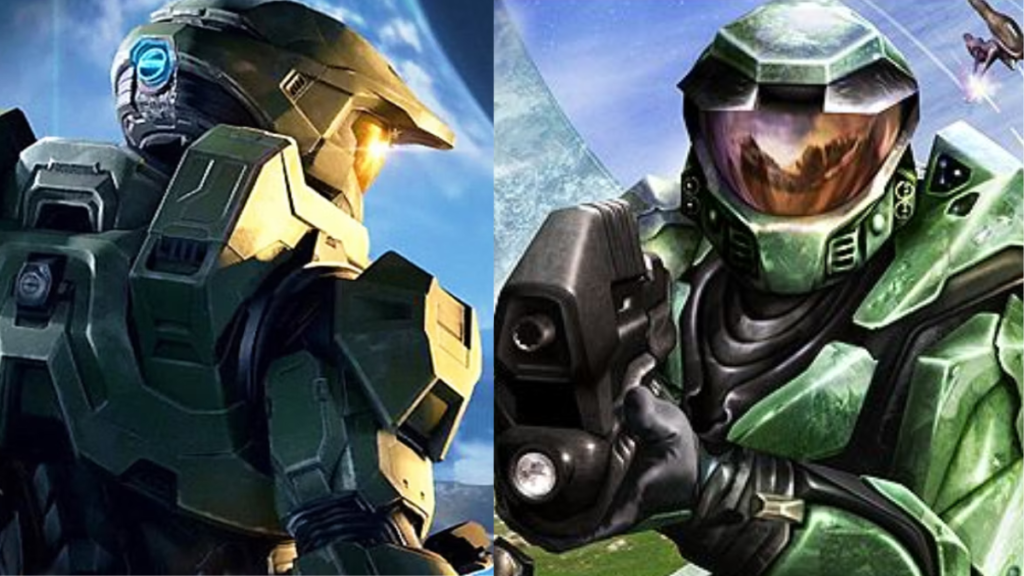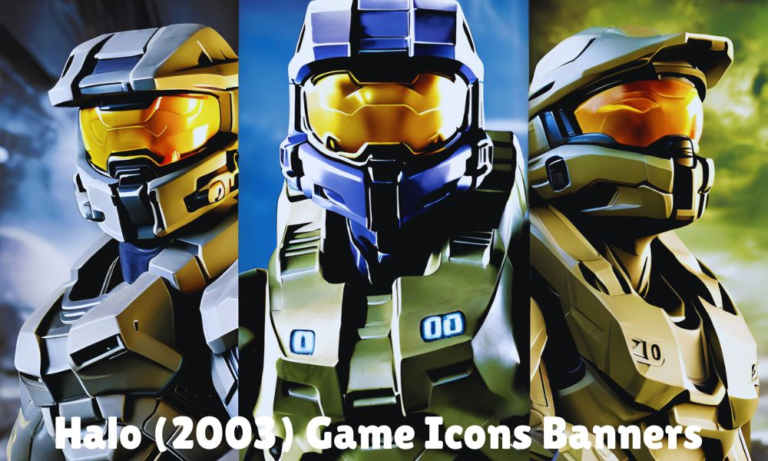Halo: Combat Evolved, released in 2003, is a seminal game that significantly impacted the first-person shooter (FPS) genre and gaming culture. With its innovative gameplay, rich story, and iconic characters, Halo quickly became a beloved franchise with a dedicated fanbase. One fascinating aspect of the game’s legacy is its visual elements, particularly the game icons and banners that players and fans have cherished over the years. This article delves into the (Halo (2003) Game Icons Banners Collection), exploring their design, significance, and evolution.
The Genesis of Halo: Combat Evolved
Before diving into the specifics of the game icons and banners, it’s essential to understand the context in which Halo: Combat Evolved was released. Developed by Bungie and published by Microsoft Game Studios, Halo was initially launched as a flagship title for the Xbox console. Its success was pivotal for Microsoft’s entry into the console market and for establishing Halo as a cultural phenomenon. The game’s setting in the 26th century, involving an interstellar war between humanity and the Covenant, captivated players with its immersive universe.

The Role of Game Icons
Game icons are crucial in how players interact with and perceive a game. For Halo: Combat Evolved, the icons used in menus, on the Xbox dashboard, and in promotional materials were meticulously designed to reflect the game’s aesthetic and themes. The primary icon, often featuring Master Chief’s helmet or the iconic Halo ring, became a symbol of the game itself.
The design of these icons is worth examining. They typically employ a combination of sleek, metallic textures with vibrant colors, which embody the futuristic and high-stakes environment of the game. The Master Chief’s helmet, for instance, is not just a character detail but a representation of the player’s identity within the game world. The use of green and blue hues in these icons aligns with the game’s color palette, creating a cohesive visual experience.
Evolution of Halo Banners
Banners are another significant visual component associated with Halo: Combat Evolved. These banners, used in promotional materials, online forums, and fan sites, have evolved, reflecting changes in the game’s branding and the community’s engagement. Initially, banners featured straightforward designs with the game’s logo and key artwork. However, as the franchise grew, so did the complexity and creativity of these banners.
Early banners often showcased the Halo ring and Master Chief in action poses, emphasizing the game’s sci-fi elements and combat focus. As the franchise expanded, banners incorporated more characters, vehicles, and scenes from the game’s universe. This evolution kept the promotional material fresh and allowed fans to connect with different aspects of the game.
Community-created banners also played a significant role in the Halo ecosystem. Fans, driven by their passion for the game, created custom banners that showcased their favorite moments, characters, and quotes. These fan-made banners contributed to the game’s enduring popularity and helped foster a sense of community among players.
Significance of Visual Elements
The icons and banners of Halo: Combat Evolved are more than mere decorative elements; they serve several essential functions. Firstly, they aid in branding. The consistent use of specific icons and design elements helps create a recognizable and memorable brand identity. For Halo, the use of Master Chief’s helmet, the Halo ring, and the game’s logo have become synonymous with the franchise, making it instantly identifiable to gamers and non-gamers alike.
Secondly, these visual elements enhance user experience. In-game icons help players navigate menus, understand controls, and identify items quickly. Effective icon design can significantly impact gameplay fluidity and player satisfaction. For instance, weapon icons in Halo are designed to be easily distinguishable, ensuring players can make swift decisions during combat.
Banners, on the other hand, play a crucial role in marketing and community building. Promotional banners help attract new players by highlighting the game’s key features and updates. Community-created banners foster engagement and allow players to express their creativity and connection to the game. Banners’ dual role in marketing and community engagement underscores their importance in the game’s overall success.
The Design Process Behind Icons and Banners
Creating the icons and banners for Halo: Combat Evolved was no small feat. It involved a collaborative effort between graphic designers, artists, and the game’s development team. The process began with understanding the game’s themes, narrative, and aesthetic. Designers had to ensure that the icons and banners looked appealing and resonated with the game’s core elements.
Initial sketches and concepts were often refined multiple times before arriving at the final designs. Readability and functionality were paramount for the icons. Designers focused on creating instantly recognizable icons that conveyed their intended function clearly. This involved a careful balance between detail and simplicity.
For banners, the emphasis was on creating visually striking compositions that captured the essence of the game. This included choosing dynamic poses for characters, selecting appropriate color schemes, and incorporating iconic elements from the game’s universe. The goal was to create banners that could capture attention and evoke excitement among the audience.
Impact on the Gaming Community
The (Halo (2003) Game Icons Banners Collection) has had a lasting impact on the gaming community. The distinctive visual style of Halo has influenced many other games and has become a reference point for sci-fi game design. The icons and banners are frequently cited in discussions about effective game branding and user interface design.
Moreover, the community’s engagement with these visual elements has been remarkable. Fans continue to create and share their icons and banners, contributing to a vibrant and dynamic online presence for the game. This ongoing interaction highlights the enduring appeal of Halo: Combat Evolved and its ability to inspire creativity among its players.

Legacy and Continued Relevance
As Halo: Combat Evolved approaches its third decade, the icons and banners from the game remain relevant and cherished by fans. The game’s visual elements have stood the test of time, continuing to evoke nostalgia and excitement. The Master Chief helmet icon, in particular, has become a cultural symbol, recognized even by those who may not have played the game.
The continued relevance of these icons and banners is also evident in their use in anniversary editions, remasters, and merchandise. The enduring popularity of Halo: Combat Evolved ensures that its visual legacy will be preserved for future generations of gamers.
Conclusion
The (Halo (2003) Game Icons Banners Collection) represents a significant aspect of the game’s legacy. These visual elements are not just functional or decorative; they are integral to the game’s identity and connection with the community. From their initial design to their evolution over the years, the icons and banners of Halo: Combat Evolved reflect the game’s impact and its place in gaming history. As we look back on the game’s legacy, it is clear that these visual elements have played a crucial role in making Halo the iconic franchise it is today.
Also, Read The Following: Pastor Chris Hodges Scandal.


